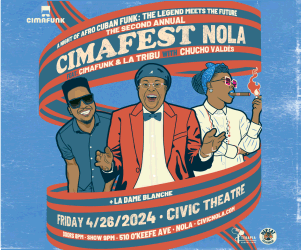Felt a bit uninspired to start the day. The stickiness was a drag and wandering the same grounds is starting to feel a bit repetitive, even if it is to see great music. Then again, I also wasn’t seeing great music. Best thing I saw early besides the wedding of Mr. and Mrs. Wayne Lee onstage in the Gospel Tent was Cedric Watson and Bijou Creole – something I definitely want to see again as it reflected an expanded Creole consciousness in a Cajun/zydeco context.
First thing to stick was the Allen Toussaint interview, which had a lot of subtle wit. He segued together a medley of Professor Longhair’s greatest hits with seemingly offhanded ease, and he tactfully, deferentially deflected a number of Ben Sandmel’s questions. Considering Toussaint’s piano style, it was a bit of a surprise when he revealed how much of an influence Professor Longhair was. He even has worked out, orchestrated charts for Longhair compositions in his files.
After that, more wandering before settling at one of the hottest sets of Jazz Fest for me – Roddie Romero and the Hub City Allstars. Romero and company are literally a South Louisiana jukebox, playing zydeco, swamp pop and the blues – all of it with a lot of groove. The last 15 minutes seemed hyperkinetic, but that might be because of the mulletted dervish dancer who threw himself with disturbing intensity into Romero’s set, jumping and spinning and swinging his dogtags. It’s possible that his nuttiness and energy merged in my brain with the music on the stage, but friends around were also pretty knocked out.
I’ve generally liked Kings of Leon on disc but found them dense and tuneless live. At the Gentilly Stage, there were a number of non-Jazz Fest elements in the show – the distortion on Caleb Followill’s voice, the fuzz bass, the triggered sequencers – but the audience that was jammed to the porto-lets suggest that notions of what does and doesn’t belong at Jazz Fest are shifting. (Or, that Jazz Fest is losing its identity and that it can accommodate any number of sounds that are neither “jazz” nor “heritage” now). Live, the U2-ness of Only By the Night was replaced by earthier sounds and that made the difference for me.
At the other end of the Fair Grounds, Bon Jovi had a crowd second only to the Dave Matthews Band crowd of 2001, which raised the question of whether Jazz Fest needs that many people, and if it does, why? And what can be done so it doesn’t need that many people?
Bon Jovi has been an easy whipping boy for this year’s festival, a benchmark of how far it’s fallen from some idyllic yesteryear, but certainly as long as I’ve been attending – over 20 years – there have always been bands who in the dark recesses of their hearts hope 50,000 or so people will see them at one time. But do they have the ability to write hooks as big as Endymion floats? The self-editing discipline to discard anything not up to that standard? The willingness to put a sing-along moment, a group handclap or some sort of corny shtick into every song to grab the audience again every three to five minutes? The talents of the entertainer may not be ones that Jazz Fest has typically embraced, but that doesn’t mean they should be overlooked. And you have to admire to confidence of someone who has the sack to open with “Living on a Prayer.”




